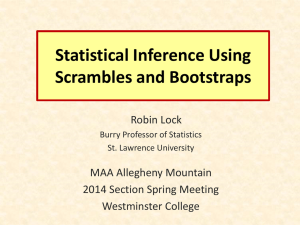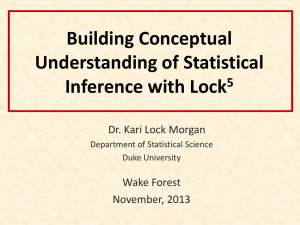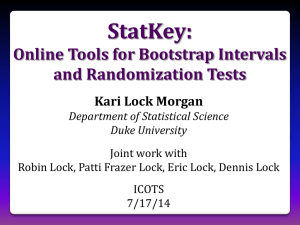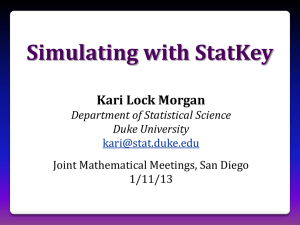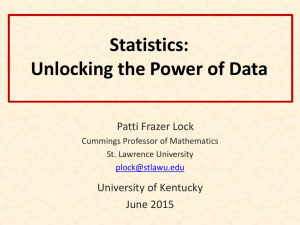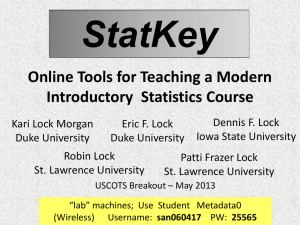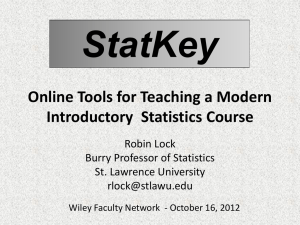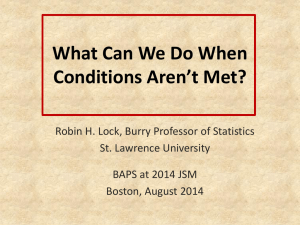Document
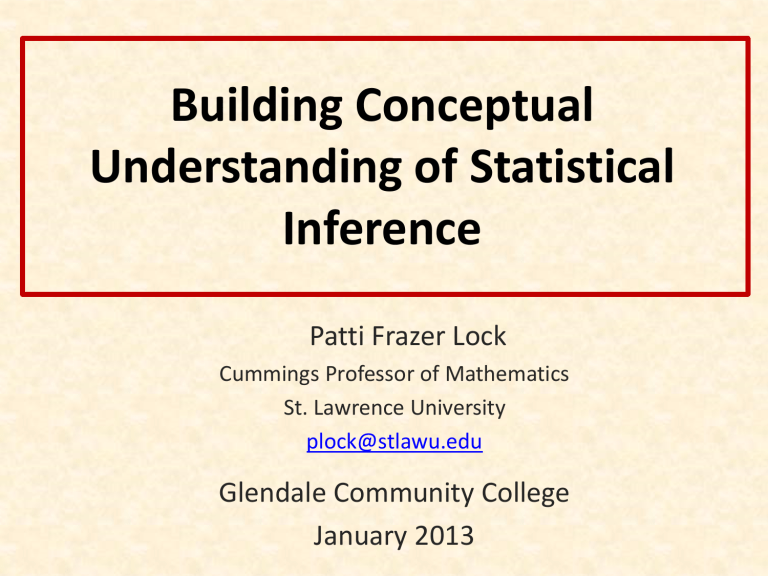
Building Conceptual
Understanding of Statistical
Inference
Patti Frazer Lock
Cummings Professor of Mathematics
St. Lawrence University plock@stlawu.edu
Glendale Community College
January 2013
The Lock 5 Team
Robin & Patti
St. Lawrence
Dennis
Iowa State
Kari
Harvard/Duke
Eric
UNC/Duke
New Simulation Methods
“The Next Big Thing”
United States Conference on Teaching
Statistics, May 2011
Common Core State Standards in
Mathematics
Increasingly used in the disciplines
New Simulation Methods
Increasingly important in DOING statistics
Outstanding for use in TEACHING statistics
Help students understand the key ideas of statistical inference
“New” Simulation Methods?
"Actually, the statistician does not carry out this very simple and very tedious process, but his conclusions have no justification beyond the fact that they agree with those which could have been arrived at by this elementary method."
-- Sir R. A. Fisher, 1936
Bootstrap Confidence Intervals and
Randomization Hypothesis Tests
First:
Bootstrap Confidence Intervals
Example 1: What is the average price of a used
Mustang car?
Select a random sample of n=25 Mustangs from a website (autotrader.com) and record the price (in $1,000’s) for each car.
Sample of Mustangs:
MustangPrice Dot Plot
0 5 10 15 20
Price
25 30 35 40 𝑛 = 25 𝑥 = 15.98 𝑠 = 11.11
45
Our best estimate for the average price of used Mustangs is $15,980, but how accurate is that estimate?
Our best estimate for the average price of used
Mustangs is $15,980, but how accurate is that estimate?
We would like some kind of margin of error or a confidence interval.
Key concept: How much can we expect the sample means to vary just by random chance?
Traditional Inference
1. Check conditions
CI for a mean
2. Which formula?
𝑥 ± 𝑧 ∗ 𝑛
OR 𝑥 ± 𝑡 ∗ 𝑛
3. Calculate summary stats 𝑛 = 25, 𝑥 = 15.98
, 𝑠 = 11.11
4. Find t * 5. df?
95% CI 𝛼
2
=
1−0.95
= 0.025
2 df=25 − 1=24 t * =2.064
6. Plug and chug
15.98 ± 2.064 ∙
11.11
25
15.98 ± 4.59 = (11.39, 20.57)
7. Interpret in context
“We are 95% confident that the mean price of all used Mustang cars is between $11,390 and
$20,570.”
We arrive at a good answer, but the process is not very helpful at building understanding of the key ideas.
In addition, our students are often great visual learners but get nervous about formulas and algebra. Can we find a way to use their visual intuition?
Brad Efron Stanford
University
Bootstrapping
“Let your data be your guide.”
Assume the “population” is many, many copies of the original sample.
Key idea: To see how a statistic behaves, we take many samples with replacement from the original sample using the same n.
Suppose we have a random sample of
6 people:
Original Sample
A simulated “population” to sample from
Bootstrap Sample: Sample with replacement from the original sample, using the same sample size.
Original Sample Bootstrap Sample
Original Sample Bootstrap Sample
Original
Sample
Sample
Statistic
Bootstrap
Sample
Bootstrap
Sample
●
●
●
Bootstrap
Statistic
Bootstrap
Statistic
●
●
●
Bootstrap
Sample
Bootstrap
Statistic
Bootstrap
Distribution
We need technology!
StatKey
www.lock5stat.com
StatKey
Standard Error 𝑠 𝑛
=
11.11
25
= 2.2
Using the Bootstrap Distribution to Get a Confidence Interval
Chop 2.5% in each tail
Keep 95% in middle
Chop 2.5% in each tail
We are 95% sure that the mean price for
Mustangs is between $11,930 and $20,238
Example 2: Collect data from you.
What is the length of your commute to work, in minutes?
Example 3: Collect data from you.
Did you teach intro stats at GCC this past Fall semester?
Why
does the bootstrap work?
Sampling Distribution
BUT, in practice we don’t see the “tree” or all of the “seeds” – we only have ONE seed
Population
µ
Bootstrap Distribution
What can we do with just one seed?
Bootstrap
“Population”
Grow a
NEW tree!
Estimate the distribution and variability (SE) of 𝑥 ’s from the bootstraps 𝑥 µ
Golden Rule of Bootstraps
The bootstrap statistics are to the original statistic as the original statistic is to the
population parameter.
Example 4: Diet Cola and Calcium
What is the difference in mean amount of calcium excreted between people who drink diet cola and people who drink water?
Find a 95% confidence interval for the difference in means.
To connect, use AIMS with password
AIMS3700
Example 4: Diet Cola and Calcium www.lock5stat.com
Statkey
Select “CI for Difference in Means”
Use the menu at the top left to find the correct dataset.
Check out the sample: what are the sample sizes? Which group excretes more in the sample?
Generate one bootstrap statistic. Compare it to the original.
Generate a full bootstrap distribution (1000 or more).
Use the “two-tailed” option to find a 95% confidence interval for the difference in means.
What is your interval? Compare it with your neighbors.
Is zero (no difference) in the interval? (If not, we can be confident that there is a difference.)
What About
Hypothesis Tests?
P-value: The probability of seeing results as extreme as, or more extreme than, the sample results, if the null hypothesis is true.
Say what????
Example 1: Beer and Mosquitoes
Does consuming beer attract mosquitoes?
Experiment:
25 volunteers drank a liter of beer,
18 volunteers drank a liter of water
Randomly assigned!
Mosquitoes were caught in traps as they approached the volunteers.
1
1 Lefvre, T., et. al., “Beer Consumption Increases Human Attractiveness to Malaria
Mosquitoes, ” PLoS ONE, 2010; 5(3): e9546.
Beer and Mosquitoes
Number of Mosquitoes
Beer Water
27 21
20 22
21 15
26 12
27 21
31 16
24 19
19 15
23 24
24 19
28 23
19 13
24 22
29 20
20 24
17 18
31 20
20
25
28
21
22
27
21
18
20
Does drinking beer actually attract mosquitoes, or is the difference just due to random chance?
Beer mean
= 23.6
Water mean
= 19.22
Beer mean – Water mean = 4.38
Traditional Inference
1. Check conditions
5. Which theoretical distribution?
2. Which formula?
X
1
X
2 s
1
2
s
2
2 n n
1 2
6. df?
7. find p-value
3. Calculate numbers and plug into formula
23 .
6
4 .
1
2
25
19
3 .
.
22
7
18
2
4. Plug into calculator
3 .
68
0.0005 < p-value < 0.001
Simulation Approach
Number of Mosquitoes
Beer Water
27 21
20 22
21 15
26 12
27 21
31 16
24 19
19 15
23 24
24 19
28 23
19 13
24 22
29 20
20 24
17 18
31 20
20
25
28
21
22
27
21
18
20
Does drinking beer actually attract mosquitoes, or is the difference just due to random chance?
Beer mean
= 23.6
Water mean
= 19.22
Beer mean – Water mean = 4.38
Simulation Approach
Beer Beverage Water
27 21
20 22
21 15
26 12
27 21
31 16
24 19
19 15
23 24
24 19
28 23
19 13
24 22
29 20
20 24
17
31 20
20
25
28
21
27 21
20 22
21 15
26 12
27 21
31 16
24 19
19 15
23 24
24 19
28 23
19 13
24 22
29 20
20 24
17 18
31 20
20 22
25
28
27
21
18
20
21
27
21
18
20
18
22
Find out how extreme these results would be, if there were no difference between beer and water.
What kinds of results would we see, just by random chance?
Simulation Approach
Number of Mosquitoes
Beer
18
12
19
18
18
24
25
21
23
24
31
13
21
27
24
19
28
22
19
27
20
23
22
Beverage
27 21
20 22
21 15
26 12
27 21
31 16
24 19
19 15
23 24
24 19
28 23
19 13
24 22
29 20
20 24
17 18
31 20
20 22
25
28
21
27
21
18
20
Water
29
17
25
20
28
24
29
20
27
23
15
22
12
20
26
31
19
Find out how extreme these results would be, if there were no difference between beer and water.
What kinds of results would we see, just by random chance?
StatKey!
www.lock5stat.com
P-value
Traditional Inference
4. Which theoretical distribution?
1. Which formula?
X
1
X
2
5. df?
s
1
2
s
2
2 n n
1 2
6. find pvalue
2. Calculate numbers and plug into formula
23 .
6
4 .
1
2
25
19
3 .
.
22
7
18
2
3. Plug into calculator
3 .
68
0.0005 < p-value < 0.001
Beer and Mosquitoes
The Conclusion!
The results seen in the experiment are very unlikely to happen just by random chance (just 1 out of
1000!)
We have strong evidence that drinking beer does attract mosquitoes!
“Randomization” Samples
Key idea: Generate samples that are
(a) based on the original sample
AND
(a) consistent with some null hypothesis.
Example 2: Malevolent Uniforms
Do sports teams with more
“malevolent” uniforms get penalized more often?
Example 2: Malevolent Uniforms
Sample
Correlation
= 0.43
Do teams with more malevolent uniforms commit more penalties, or is the relationship just due to random chance?
Simulation Approach
Sample Correlation = 0.43
Find out how extreme this correlation would be, if there is no relationship between uniform malevolence and penalties.
What kinds of results would we see, just by random chance?
Randomization by Scrambling
Original sample 𝑟 = 0.43
Scrambled sample 𝑟 = −0.03
18
19
20
21
14
15
16
17
22
23
9
10
11
12
13
7
8
5
6
MalevolentUniformsNFL
NFLTeam NFL_Ma... ZPenYds <new>
1
2
LA Raiders
Pittsburgh
5.1
5
1.19
0.48
3
4
Cincinnati
New Orl...
4.97
4.83
0.27
0.1
Chicago
Kansas ...
Washing...
St. Louis
NY Jets
LA Rams
Cleveland
San Diego
Green Bay
4.68
4.58
4.4
4.27
4.12
4.1
4.05
4.05
4
0.29
-0.19
-0.07
-0.01
0.01
-0.09
0.44
0.27
-0.73
Philadel...
Minnesota
Atlanta
Indianap...
San Fra...
Seattle
Denver
Tampa B...
New Eng...
Buffalo
3.97
3.9
3.87
3.83
3.83
3.82
3.8
3.77
3.6
3.53
-0.49
-0.81
0.3
-0.19
0.09
0.02
0.24
-0.41
-0.18
0.63
17
18
19
14
15
16
20
21
22
23
9
10
11
12
13
4
5
6
7
8
Scrambled MalevolentUniformsNFL
NFLTeam NFL_Ma... ZPenYds <new>
1 LA Raiders 5.1
0.44
2
3
Pittsburgh
Cincinnati
5
4.97
-0.81
0.38
New Orl...
Chicago
Kansas ...
Washing...
St. Louis
4.83
4.68
4.58
4.4
4.27
0.1
0.63
0.3
-0.41
-1.6
NY Jets
LA Rams
Cleveland
San Diego
Green Bay
Philadel...
Minnesota
Atlanta
Indianap...
San Fra...
Seattle
Denver
Tampa B...
New Eng...
Buffalo
4.12
4.1
4.05
4.05
4
3.97
3.9
3.87
3.83
3.83
3.82
3.8
3.77
3.6
3.53
-0.07
-0.18
0.01
1.19
-0.19
0.27
-0.01
0.02
0.23
0.04
-0.09
-0.49
-0.19
-0.73
0.09
StatKey www.lock5stat.com/statkey
P-value
Malevolent Uniforms
The Conclusion!
The results seen in the study are unlikely to happen just by random chance (just about 1 out of 100).
We have some evidence that teams with more malevolent uniforms get more penalties.
P-value: The probability of seeing results as extreme as, or more extreme than, the sample results, if the null hypothesis is true.
Yeah – that makes sense!
Example 3:
Light at Night and Weight Gain
Does leaving a light on at night affect weight gain? In particular, do mice with a light on at night gain more weight than mice with a normal light/dark cycle?
Find the p-value and use it to make a conclusion.
Example 3:
Light at Night and Weight Gain www.lock5stat.com
Statkey
Select “Test for Difference in Means”
Use the menu at the top left to find the correct dataset (Fat Mice).
Check out the sample: what are the sample sizes? Which group gains more weight? (LL = light at night, LD = normal light/dark)
Generate one randomization statistic. Compare it to the original.
Generate a full randomization (1000 or more).
Use the “right-tailed” option to find the p-value.
What is your p-value? Compare it with your neighbors.
Is the sample difference of 5 likely to be just by random chance?
What can we conclude about light at night and weight gain?
Simulation Methods
• These randomization-based methods tie directly to the key ideas of statistical inference.
• They are ideal for building conceptual understanding of the key ideas.
• Not only are these methods great for teaching statistics, but they are increasingly being used for doing statistics.
How does everything fit together?
• We use these methods to build understanding of the key ideas.
• We then cover traditional normal and ttests as “short-cut formulas”.
• Students continue to see all the standard methods but with a deeper understanding of the meaning.
Intro Stat – Revise the Topics
• • Descriptive Statistics – one and two samples
• •
•
• Normal distributions
Bootstrap confidence intervals
•
•
• Randomization-based hypothesis tests
• Normal distributions
• Confidence intervals (means/proportions)
• Hypothesis tests (means/proportions)
• Probability OR ANOVA for several means,
Inference for regression, Chi-square tests
It is the way of the past…
"Actually, the statistician does not carry out this very simple and very tedious process, but his conclusions have no justification beyond the fact that they agree with those which could have been arrived at by this elementary method."
-- Sir R. A. Fisher, 1936
… and the way of the future
“... the consensus curriculum is still an unwitting prisoner of history. What we teach is largely the technical machinery of numerical approximations based on the normal distribution and its many subsidiary cogs. This machinery was once necessary, because the conceptually simpler alternative based on permutations was computationally beyond our reach. Before computers statisticians had no choice. These days we have no excuse. Randomization-based inference makes a direct connection between data production and the logic of inference that deserves to be at the core of every introductory course.”
-- Professor George Cobb, 2007
Additional Resources www.lock5stat.com
Statkey
• Descriptive Statistics
• Sampling Distributions
• Normal and t-Distributions
Thanks for joining me!
plock@stlawu.edu
www.lock5stat.com
